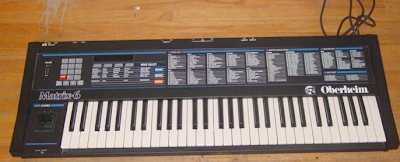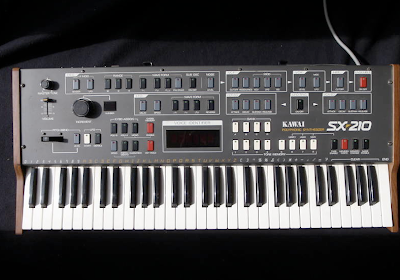 Info at the listing...
Info at the listing...Saturday, October 31, 2009
Friday, October 30, 2009
Free Sample Friday: Synthetic Kick Drums

Here's 20 synthesized kicks created on the Virus, Microtonic, Reaktor, and Ultrabeat and processed with a Focusrite Liquid Mix. Enjoy!
Labels:
Drums,
Free Sample Friday,
Free Samples
"Moog Filter" Arp Odyssey on Ebay
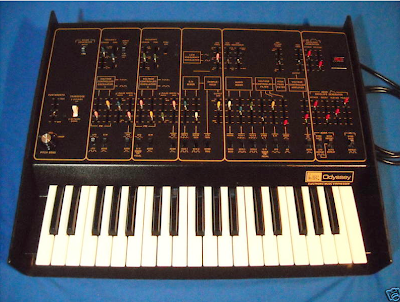
This is the version of the Arp Odyssey that was released before Arp was sued by Moog for infringing on Moog's ladder filter design...
Labels:
Arp,
Rare Instruments
Thursday, October 29, 2009
Upcoming Software Emulates a 1950's Electronic Music Studio
Introducing Berna vintage electronic studio from Tobor Experiment on Vimeo.
This looks a lot of fun! Thanks to alert reader Rod for sending it my way!
Labels:
Mac Software
Review: Wave Alchemy Drum Machines 01
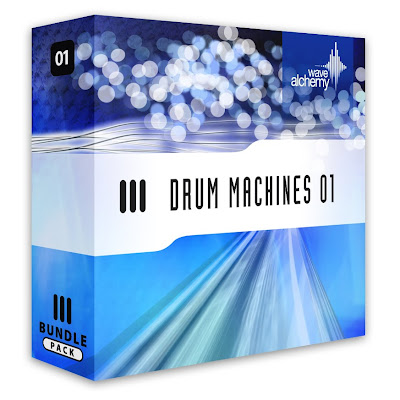
Library: Drum Machines 01
Format: Downloadable WAVs
Genre: Any genre that need electronic drum sounds
Distributed by: Wave Alchemy
Price: £22
Demo: On product page
When I was a kid, there was an old house up the street where two elderly eccentric brothers lived together. These guys were "hoarders" - they never threw anything away and their house was filled floor to ceiling with boxes, old newspapers, trash, and assorted other stuff most of us would have thrown away. Their hoarding problem was so bad that they eventually had to move out onto the porch of their house. Well... I'm kind of that way with drum samples. I already have more drum samples on my hard drive than any mere mortal could possibly use in a lifetime, and yet, I constantly find myself looking for more. So, along comes sample developers Wave Alchemy with a new bundle of electronic drums sounds to feed my addiction. I believe that makes them enablers. And when the samples are as good as these, that's okay with me.
Drum Machines 01 is actually a repackaging of 3 "micropacks" of electronic drum sounds previously released by Wave Alchemy called Airbase Drums, Deep Drums, and Electric Drums. Collectively, the sounds in these collections come from some of the famous boutique drum machines from Jomox such as the Airbase 99, Xbase 999, and the Mbase 11, as well as 1 machine from Vermona (the DRM Mk-II). Wave Alchemy says these sounds were all recorded through an API 512c pre-amp and were further processed with an Empirical Labs Distressor and various SSL equalizers.
There are 1,400 samples here with the following breakdown:
· 128 AIRBase99 kick drums
· 245 MBase11 kick drums
· 41 AIRBase99 clap & snare drum samples
· 52 AIRBase99 hihats & toms
· 16 AIRBase99 percussion & crash cymbal samples
· 150 Vermona DRM MK11 kick drums & subs
· 96 Vermona DRM MK11 snare drum & luxury clap samples
· 65 Vermona DRM MK11 hihats & toms
· 122 Vermona DRM MK11 percussion samples
· 20 Vermona DRM MK11 sound effects
· 215 XBase999 kick drums
· 115 XBase999 clap & snare drum samples
· 40 XBase999 hihats
· 57 XBase999 toms
· 39 XBase999 percussion & crash cymbal samples
So yeah... there are a few sounds here and in case you missed it, they're only asking £22 for the whole shebang! But how do they sound? In keeping with Wave Alchemy's previous releases, they sound excellent. The kicks have punch, weight, and presence, the snares have lots of snap, and the cymbals all have a pleasant sizzle. There is a good balance here between variety of sounds and offering small variations thereof. Some people may wish there were simply a lot of sounds that are totally different from one another, but the addition of the subtle variations really is the next best thing to actually owning the drum machines yourself and gives you a ton of flexibility.
I'm not going to go through and describe each and every sound for you since that would make for a pretty boring read, but I can go into the general character of the machines sampled. The Airbase 99 is probably the nicest sounding of the lot, producing sounds somewhere between a Roland TR-909 and 808. There are some more synthy sounding timbres here as well, but for the most part, if you are a fan of the TR sound, you're know what to expect. The Mbase 11 is Jomox's dedicated kick drum synth and it is an absolute monster. The usual 909 and 808 kicks are present here, some clean, some overdriven and nasty. Additionally, you'll find all manner of electronic kicks from tight goa kicks to sustaining subs that'll rattle your teeth. The Xbase 999 is similar in concept to the Airbase 99, but I found it to have a decidedly more synthetic sound. Finally, the Vermona DRM Mk-II is the most synthetic-sounding of all, sounding more like the types of drum and percussion sounds you'd get from an analog monosynth or a vintage modular.
What's not here? Well, if you're after clickier kicks or more digital sounding drums, this isn't for you. The sounds here are as analog as it gets and if that is your sort of thing, this collection is going to keep you happy for a very long time. My only complaint is that there are no pre-mapped sample instruments (EXS, Kontakt, Reason, etc.), so you will have to map the sounds out yourself. But at this price, that seems an awfully petty thing to complain about. Indeed, if you make dance music, you'd be a fool to pass this collection up. (10/10)
Labels:
Jomox,
Reviews,
Sample Libraries,
Vermona
Wednesday, October 28, 2009
"Where'd That Sample Come From?"
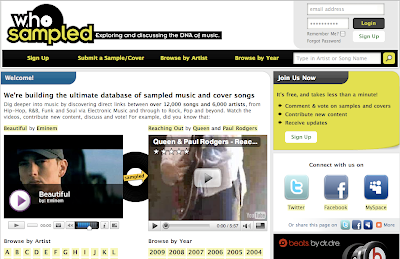 In my travels around the Interweb Tubes last night, I stumbled across an interesting site called WhoSampled which is building a database cataloging which artists sampled which other artists in detail. Looks like it's been around for awhile, but it was the first I had heard of it.
In my travels around the Interweb Tubes last night, I stumbled across an interesting site called WhoSampled which is building a database cataloging which artists sampled which other artists in detail. Looks like it's been around for awhile, but it was the first I had heard of it.
Got Synth?
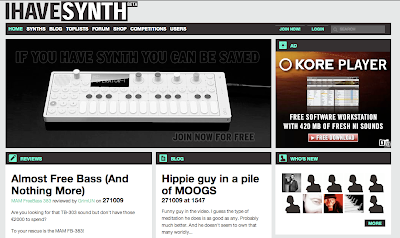 IHaveSynth (currently in Beta) is a new site for all things synth-related. It looks to be pretty ambitious too, consisting as it does of news, reviews, a blog, a forum, and more. Be sure to go on over and check it out!
IHaveSynth (currently in Beta) is a new site for all things synth-related. It looks to be pretty ambitious too, consisting as it does of news, reviews, a blog, a forum, and more. Be sure to go on over and check it out!
Labels:
Blog Recommendations
Tuesday, October 27, 2009
A Look At Logic's Different Flex Modes
 Logic's "Flex Time" feature is easily the most significant upgrade in Logic 9. It is mainly intended to offer the same 'elastic audio' abilities Ableton Live is known for, for matching tempos of audio snippets or quantizing audio just like it was MIDI. But my first thought when I heard about it was "How can I abuse this for some cool effects?" Turns out it's pretty damn good for that too.
Logic's "Flex Time" feature is easily the most significant upgrade in Logic 9. It is mainly intended to offer the same 'elastic audio' abilities Ableton Live is known for, for matching tempos of audio snippets or quantizing audio just like it was MIDI. But my first thought when I heard about it was "How can I abuse this for some cool effects?" Turns out it's pretty damn good for that too.What makes it great for sound design and abuse is that it features several different flex modes specializing in different types of audio. Each one sounds a bit different and produces different kinds of artifacts when pushed to extremes, so I thought today I'd talk a little about those and give some examples.
To demonstrate the way these different modes sound, I took a short vocal and time-compressed some bits, while stretching out others at random. So while these examples may not be terribly musical, it gives you an idea of how the different modes could be used for special effects. The piece of audio and the portions that are stretched or compressed are the same in every instance. Only the Flex Mode was changed.
The first mode available is the SLICING mode. You can think of this as being similar to Propellerheads' Recycle. Its specialty is drum and percussion loops. It looks for attack transients and divides the file into slices so that when you adjust the tempo of your project, the drum or percussion loop plays in time at the new tempo without playing at a higher/lower pitch. Used on non-rhythmic material, its effect is a bit like gating:
The next available mode is the RHYTHMIC mode. This is similar to the SLICING mode in both function and sound, but it is aimed more at non-drum or percussion-based rhythmic parts such as a clav or rhythm guitar riff. Here is the same piece of audio used above, this time in RHYTHMIC mode:
The MONOPHONIC mode is specifically designed to be used on melodic instruments only playing a single note at a time, such a singer's voice. Although it is a more hi-fi type of time stretching, at extremes, you still get some cool artifacts:
As you might guess, the POLYPHONIC mode works in a similar way, but adapted for use with material where chords or intervals are present in the material. It creates a subtly different kind of audio artifact that sounds like this:
The TEMPOPHONE mode might be better named the "old school" mode because it emulates the time stretching algorhythms used by early samplers and computer audio editors. You've no doubt heard this effect on countless 90's dance tracks. It has a bit of a metallic/robotic sound to it:
Whereas the other modes are designed to effect timing without effecting pitch, the SPEED mode essentially emulates the behavior of tape. Audio you stretch out will play at a lower pitch, while audio you compress will sound "munchkinized". Combining the two can create some crazy effects like you might hear on an old Severed Heads record:
Labels:
Logic,
Sound Design
Monday, October 26, 2009
Shameless
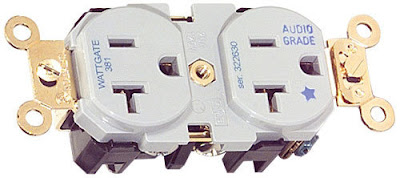 I curse Gizmodo for bringing this to my attention...
I curse Gizmodo for bringing this to my attention...I don't even know where to start with this one. I'm not going to mention the name of the company, although you can probably figure it out, but an amazingly gutsy group of d-bags have decided to try and market "audio grade" power outlets for the oh-so-reasonable price of nearly $150 a pop. Because, you know, what's keeping your band from sounding like U2 is the quality of your power outlets.
Seriously, if you're thinking of outfitting your studio with these, please just send the $150 to my PayPal account and then punch yourself in the groin. I guarantee it will have just as much effect on your music.
Labels:
WTF
THIS is Kind of Interesting, Though...
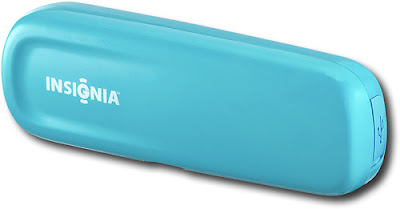 Also courtesy of Gizmodo...
Also courtesy of Gizmodo...If you are a touring performer, at some point or another, you are going to lose gear. Whether you absent-mindedly leave your audio interface in a venue or, as happened to me many years ago, your band's entire U-Haul trailer gets swiped, if you play any amount of live shows, you're probably going to have some gear go missing.
The Insignia Little Buddy is a device designed to put somewhere on the person of your child to keep track of them, especially, one presumes, if they were kidnapped. I think this is an idea waiting to be adapted for musicians, however. The current model is a bit bulky for this purpose, but imagine if it came in an ultra-thin "sticker" form. You could open up each piece of gear, attach the sticker/GPS transmitter to the inner lid of said gear, and in the event that it got stolen or forgotten in a hotel room somewhere, you could look up its location instantly.
I've heard rumors of similar products for musicians, but nothing that really seemed ready for prime time yet. I'm telling you, though, the company that puts this in sticker form and offers a cheap monitoring charge is going to make a lot of money.
Sunday, October 25, 2009
Friday, October 23, 2009
Free Sample Friday: SH-101 Percussion

It's the weekend! Woohoo! Here to start your weekend off right are 20 synth percussion sounds from my Novamodded Roland SH-101 as 24-bit/44.1k WAV files. Enjoy!
GO GET THEM!
Labels:
Free Sample Friday,
Free Samples
Thursday, October 22, 2009
Wave Alchemy Launches New Site
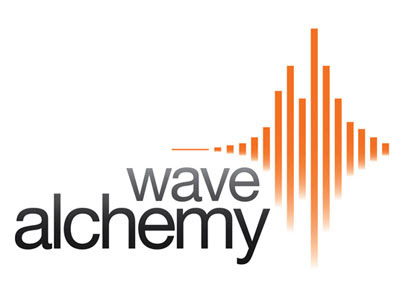
Up and coming sample developers Wave Alchemy have launched their own website. Here's what they say you'll find there:
"• Digital Download sample shop
• Buy directly from Wave Alchemy
• Interact with Wave Alchemy Sound Designers
• Sign up for access to over 250MB of high quality free samples taken from our products
•Read what established artists/producers have to say about our products
• Read Industry reviews
• Use our custom built Wave Alchemy mp3 player to listen before you buy
• Right Click save as function for every one of our product demos (listen to the demos on your studio monitors).
• Order with confidence with our secure ordering and payment system through Paypal
• Start Downloading your purchases within 3 min"
Labels:
Sample Libraries
Review: Plogue's Chipsounds
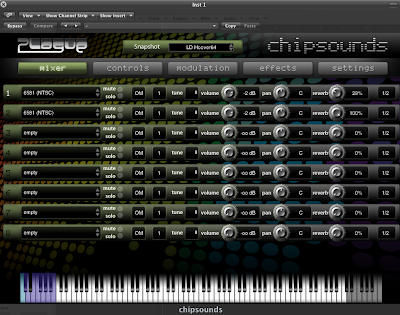 Product: Chipsounds softsynth
Product: Chipsounds softsynthType: Softsynth emulation of classic computer/gaming sound chips
Formats: VST, AU (OS X only), RTAS, Standalone
System Requirements: PC: Windows XP or better,2.8gHz Pentium 4 or better, 1GB RAM. MAC: OS 10.4 or better, Intel Core Duo Processor or better, 1 GB RAM
Manufacturer: Plogue
Support: Plogue YouTube Channel, Plogue User Forum
Price: $75 (limited time offer).
I grew up in a small town in New Hampshire called Lyme. Despite how small our elementary school was (less than 100 students in total), we always had a really good computer education program. We learned not only the basic operation of a computer and peripherals, but even learned some programming in BASIC, LOGO, and other now-outmoded languages. The computers we had were mostly Commodore 64's and one day in class, I noticed in the back of the manual there was a section about the synthesis chip (the now famous SID chip) and how to use it. I couldn't yet afford a synthesizer at this point (I was only in 5th grade), so I had a go at programming a little synthesizer program for the C64. There wasn't much to it, but you could do basic editing to the sound and play it from the keyboard and it didn't sound half bad. Little could I have known back then how popular 'obsolete' computer and gaming console chips would become in the electronic music underground decades later. While there have been previous softsynths aimed at recreating these types of sounds, so far none have been as ambitious as the latest offering from Plogue called, appropriately enough, Chipsounds. So how have they done? Read on...
INSTALLATION
Installation is a standard affair with an installer program taking care of all the grunt work. Once you've registered your product, you will be issued your copy protection key which comes in the form of a graphics file in PNG format that you drag onto the GUI of the softsynth when you first launch it. Please note there is a bug in Logic 9 that prevents the drag and drop authorization from within Logic itself. The solution here is simply to launch the standalone version and authorize it there (this also authorizes the plug-in versions).
DOCUMENTATION
Documentation for the program comes in the form of a PDF file. Plogue indicates that this is a work in process, but for the most part it's very good, if a bit of a dry read. Helpfully, the manual makes notes throughout wherever Chipsounds strays a bit from the limitations of the original chips for those who are sticklers for absolute authenticity. There's also a nice section containing some history on each of the chips and what made them unique for some good, geeky fun.
USER INTERFACE
I'm just going to come out and say it. The interface is ugly as sin. Fortunately, it is entirely skinnable if you're willing to get your hands a little dirty. And unless colors like pea-soup green or sickly mustard yellow are your bag, you'll probably want to give it a go. That said, the interface is easy to understand and well-organized. The layout doesn't seem quite as efficient as it could be, but does leave room open for future expansion and is, at least to a degree, necessary considering that some chips offer different, unique functions not available on others. Overall though, despite not being pretty to look at, the interface is very easy to understand and navigate even without cracking the manual.
OVERVIEW
Chipsounds opens to the MIXER page which gives users access to up to 8 slots in which to load different chip emulations. These can either be layered in OMNI mode, or can be triggered individually via multi-timbral operation. Each slot offers settings for MIDI channel, tuning, volume, panning, reverb amount, etc. You can think of this similarly to the 'MULTI' mode in many hardware synths allowing you to either set up different sounds per MIDI channel, or layer and detune multiple sounds to harness the power of up to 8 different chips at once for sounds that would've been tough to create in the old days.
Before we go on, it's worth mentioning a little bit about the chip emulations themselves. There are tons of options here from such historic machines as the Commodore 64, the Atari 400, the VIC-20, the Super NES, the Casio VL-1, Colecovision, Intellivision, etc. At the present time, some chips are emulated with samples, where others are directly modeled. Plogue indicates that in future versions, all chips will be modeled (although the samples will still be available for the purpose of backwards compatibility. In addition to the standard waveforms offered by each chip, Plogue has graciously included some cool 'extras' such as a small selection of 4-bit sampled drum sounds, and a couple sounds produced by misbehaving chips. Even listening to the raw sounds, there is a nice variety of timbres to start from, all with those unique sonic qualities that make these old chips sound different from modern synthesizers.
The next page of parameters is the CONTROLS page which consists of settings unique to each chip model, an ARPEGGIATOR, and a WAVESEQUENCER. Tabs on the left side of the interface let you access each of the 8 available slots individually and easily which makes programming more complex sounds a breeze.
The ARPEGGIATOR is inspired by the very basic arpeggiator on the Roland Juno 60. As such, it's really intended more as a performance feature than as a sound design source. A nice addition, but by no means an essential part of the instrument.
Instead, the types of rapid arps and burbling bloops you might expect to create with an arpeggiator are created in the WAVESEQUENCER. Indeed, the WAVESEQUENCER is rather integral to the creation of a lot of classic video game sounds and is really the key to getting the most out of this instrument. Note values and parameters such as NOTE ON, NOTE OFF, PITCH, and CC modulation are entered on a grid here that takes a little getting used to at first, but that is not too bad to use one you get used to how its set up. That said, I think this could be implemented in a much more intuitive/visual way such as the step sequencers featured on many softsynths such as Native Instruments Massive. I think a little visual feedback would make this a lot more simple for the average user. Each chip slot can have up to 12 different wave sequences that can be mapped as you see fit across the keyboard. So even with a single chip, you can see the potential for creating a broad range of sounds and effects using the WAVESEQUENCER alone.
Next, we have the chip-specific parameters window which contains any parameters that are unique to a specific chip. Some have no additional parameters at all, while others offer several parameters to let you further sculpt the sound.
The final component of the CONTROLS page is the OSCILLISCOPE that lets you visualize the sounds you are playing. (This actually appears on the MODULATION page as well).
The third available programming page is the MODULATION page which contains standard style envelopes for modulating both PITCH and AMPLITUDE, an LFO for modulating pitch, and an extremely basic PORTAMENTO mode. Some users may be a bit surprised by the relative dearth of parameters here, but these reflect the way the original chips worked and, frankly, the limitations of those chips lead to some very clever tricks used by programmers to extend the range of sounds possible (see especially the previously mentioned WAVESEQUENCER). I like that Chipsounds encourages users to discover some of the old workarounds for creating unique sounds.
The next page over is the EFFECTS page, which presently consists solely of a REVERB effect. The REVERB sounds very good and is as flexible as you could hope for, but I did feel like the lack of other effects was a bit of a shame. Plogue has indicated that they do intend to introduce more effects in future versions, but for the time being, you may need to rely more on external plug-ins to put that final bit of polish on your sounds. No doubt the raw sound of Chipsounds is cool in its own way, but a wider variety of effects will help users create more contemporary sounds and vastly expand the usefulness of this instrument.
Finally, we have the SETTINGS page which contains info on various settings (sample rate, buffer size, etc), your licensing, and a link to the online support from Plogue.
SO HOW DOES IT SOUND?
In a word: awesome. I obviously don't have a stack of the original machines on hand to A/B Chipsounds direectly with the originals, but I've used more of these machines in my childhood than I care to admit. Playing with Chipsounds brought tons of these childhood memories rushing back... playing Frogger on my friend's dad's Atari 800... playing the little Casio VL-1 another friend had... my own experiments with my grade school's Commodore 64. The personality of these chips comes through in droves and makes this a must have for anyone nostalgic for these archaic means of sound production, whether they're a musician or not.
But while Chipsounds takes great pains to remain faithful to the limitations of the original chips, it's the possibility to harness up to 8 of these chips at once that breathes new life and possibilities into them. You can make some very thick and powerful sounds you might not expect to get from classic chips if you take the time to layer and experiment. This is one aspect I found Chipsounds really excelled at over similarly themed softsynths. Previous softsynths emulating chips I have used sounded cool enough, but ultimately they always sound like chip sounds. Chipsounds can obviously make those sounds without breaking a sweat, but it is also capable of some very useful, "un-chip like" sounds with a little work.
So who is going to find this the most useful? If you're into making chiptunes, this is a no-brainer. Just buy it. With chip sounds making their way into an increasing number of genres these days, it will also appeal to people looking to introduce some different and unique timbres into their songs not attainable on your standard virtual analog. Once you start to experiment with layering and building more complex sounds, it becomes immediately obvious that this will also become a favorite among musicians doing styles such as electro house where its aggressively digital sound is a natural fit.
What excites me most about Chipsounds is the possibilities for the future. I'd love to see a couple options that weren't present in the original machine introduced here. A filter section would definitely expand the possibilities (a handful of chips have filters available as their chip-specific settings), a more useful and flexible Portamento function would be great, and, as mentioned before, a wider array of effects would be a nice addition. That said, imposing the limitations of the original chips is not a bad thing in my opinion. It encourages the same kind of creative thinking and workarounds the original programmers used to use back in the day to get sounds you wouldn't expect to be possible with such limited means. Plogue has approached this softsynth with a palpable sense of reverence and their affection for these outdated sound makers shines through in abundance. An exceptionally fun and unique instrument! [8/10]
Labels:
Chiptunes,
Reviews,
Softsynths
Wednesday, October 21, 2009
Error Messages
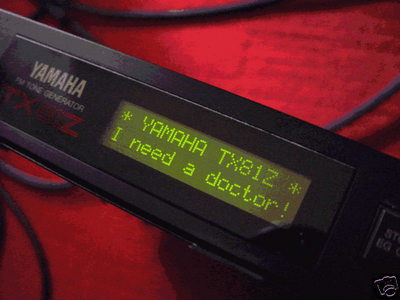 I saw this picture over on Matrixsynth and it reminded me of a funny story related to synth error messages (now there's a sentence you don't read every day!)
I saw this picture over on Matrixsynth and it reminded me of a funny story related to synth error messages (now there's a sentence you don't read every day!)My band was playing a show somewhere in Germany. I forget precisely where it was, but it may have been Berlin. For this particular tour, my keyboard player, Paul, brought along a Waldorf Microwave XTk to play onstage. We were in the middle of a song when I suddenly noticed Paul's keys just dropped out of the mix entirely. I look over to see him bent over peering at the display... never a good sign. Out of nowhere Paul starts laughing and motions me over. I don't remember the precise wording of the error message, but it was something like 'CATASTROPHE! TOTAL FAILURE!' We both agreed that the Germans certainly had a way of capturing the feeling of having one of your instruments take a dump in the middle of a show.
Have you ever experienced one of these moments in the studio or on stage? Are there other synths with amusing/quirky error messages that you've seen?
Cool Homemade Poly Synth
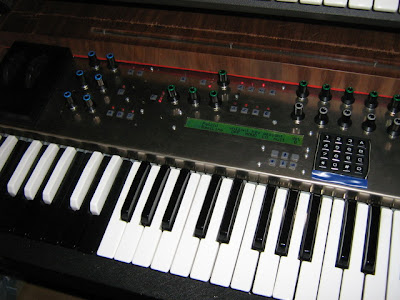 I must've missed when it was first posted a couple of weeks ago on Vintage Synth Explorer, so apologies if this already made the rounds, but this a home made poly synth made by someone in Poland who is much smarter than you and I.
I must've missed when it was first posted a couple of weeks ago on Vintage Synth Explorer, so apologies if this already made the rounds, but this a home made poly synth made by someone in Poland who is much smarter than you and I. Features include:
"- 5 voices
- 2xVCO per voice
- 3xEG per voice (hardwired to pitch, cutoff and volume)
- 3xLFO (pitch, cutoff and PWM)
- Moog ladder VCF
- Noise source
- Ring Modulator
- Patch memory (128 user patches)
- MIDI
- Mono mode with selectable note priority (High/Low) and triggering (single/multi) and with portamento
- unison with adjustable detuning
VCO A offers sawtooth, square and triangle. VCO B offers sawtooth and square waves. Having triangle wave available is essential if you want to obtain some nice fm-like sounds from RingMod.
It's built using only standard off-the-shelf components - no CEM or SSM or similar chips inside - only typical opamps, switches, transistors etc.
Case (together with keyboard) was salvaged from some crappy 70's combo organ."
- 2xVCO per voice
- 3xEG per voice (hardwired to pitch, cutoff and volume)
- 3xLFO (pitch, cutoff and PWM)
- Moog ladder VCF
- Noise source
- Ring Modulator
- Patch memory (128 user patches)
- MIDI
- Mono mode with selectable note priority (High/Low) and triggering (single/multi) and with portamento
- unison with adjustable detuning
VCO A offers sawtooth, square and triangle. VCO B offers sawtooth and square waves. Having triangle wave available is essential if you want to obtain some nice fm-like sounds from RingMod.
It's built using only standard off-the-shelf components - no CEM or SSM or similar chips inside - only typical opamps, switches, transistors etc.
Case (together with keyboard) was salvaged from some crappy 70's combo organ."
Read more about it in the original thread...
Labels:
Homemade Gear,
Rare Instruments
Tuesday, October 20, 2009
Shiny New Toys from Apple

As you may have heard by now, Apple announced a number of new products today. This includes new additions to the iMac and Mac mini lines, a new sub $1,0000 Macbook (with a built in 7-hour battery!), and a totally redesigned mouse called the Magic Mouse which allows various multi-touch functions just using the surface of the mouse itself (no more scroll wheel to get gummed up!).
Labels:
Apple
Happy Release Day to Me!
Labels:
Crass Plugs
Monday, October 19, 2009
Mixing It Up
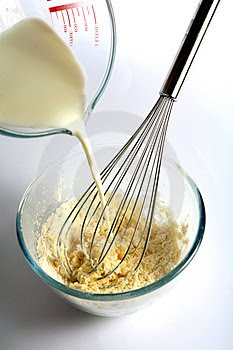 So today I'm going to be starting on a remix for another band. The process of remixing is quite a bit different from writing a song from scratch in that you usually have at least one piece (say, a vocal) from a finished song that you have to build your remix around. In a sense, you're putting together a puzzle. Unlike a regular puzzle, however, the remixing puzzle has several ways it can be assembled "properly". So today I thought I'd talk a little bit about how I go through the process..
So today I'm going to be starting on a remix for another band. The process of remixing is quite a bit different from writing a song from scratch in that you usually have at least one piece (say, a vocal) from a finished song that you have to build your remix around. In a sense, you're putting together a puzzle. Unlike a regular puzzle, however, the remixing puzzle has several ways it can be assembled "properly". So today I thought I'd talk a little bit about how I go through the process..1. First, I give the original song a listen. This is helpful in getting an idea of the basic song structure and the general sound of the track. I personally like to approach remixes almost like writing an entirely new track that just happens to have the same vocal as the original. So usually during this time I'm listening for things I can do differently from the original. After I've listened once or twice, I don't listen to the original version again until I am finished.
2. After setting my DAW's tempo to the tempo of the track, I drop the vocal track into Logic. I usually call up an instance of StylusRMX with a simple drum loop in it to keep time. Most of the time, I then create a new track with a bass sound of some sort. I set up a section of the vocal to loop and begin trying out different basslines/note progressions against the vocal until I find something I like.
3. Once I've done the above for any intros, verses, chorus, and bridges, I copy and paste these parts throughout the entire song to build the structure of the track. If I want to structure things differently, add a break-down, etc., I usually handle that during this stage too.
4. The bulk of the work at this point entails 'coloring in' this basic skeleton of a song. I try to get the sounds as close to what I think I'll want in the final mix, but it's more important to write the actual synth parts and flesh out the drum parts at this stage.
5. The final stage before actual mixdown is usually spent fine-tuning and layering sounds, applying appropriate effects, adding special effects and ear candy, etc. For me, this is one of the most fun parts of the process.
Once I have everything just about where I wanted it, I record the tracks, mix them down, and give it a final listen compared to the original. I make some last minute tweaks, as necessary, and then I usually let it sit for a day or two so I can come back to it and listen again with fresh ears to make final adjustments. Of course, sometimes you don't have this luxury (I've had to turn around remixes in 24 hours before), but I almost always find something I feel needs to be adjusted.
This is just one possible path. Just about everyone who does remixes has their own preferred method and, of course, there really is no 'wrong' way to do it. What's your remixing process like?
Labels:
Remixing
Sunday, October 18, 2009
Saturday, October 17, 2009
Imperative Reaction Gear on Ebay
 My friends from the industrial band Imperative Reaction are selling some gear... check it out.
My friends from the industrial band Imperative Reaction are selling some gear... check it out.Friday, October 16, 2009
Open Thread Friday: Plug Yourself!
 I'm a little burned out from spending the past two weeks shipping out pre-orders for the new album, so I'm copping out today. Reply to this thread to plug your music, blog, website, cool software project, or whatever!
I'm a little burned out from spending the past two weeks shipping out pre-orders for the new album, so I'm copping out today. Reply to this thread to plug your music, blog, website, cool software project, or whatever!We'll have some more Free Sample Fridays coming up soon, too!
Labels:
Open Threads
Roland Jupiter 6 with Europa Mod on Ebay
Labels:
Roland,
Synth Modifications
Thursday, October 15, 2009
Get AAS Ultra Analog VA-1 for $15!
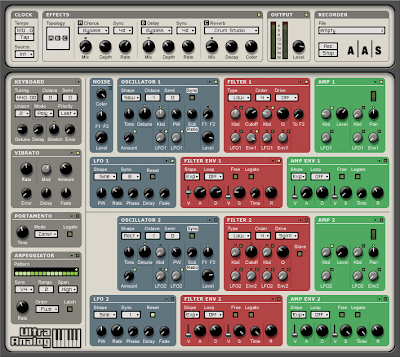 A few weeks ago I posted about AudioMIDI.com offering PSP's excellent Nitro filter for super cheap. Looks like they intend to make the ridiculous deals a regular thing because now you can get Applied Acoustics Systems Ultra Analog VA-1 (normally $200) for a paltry $15. The deal lasts until November 30th.
A few weeks ago I posted about AudioMIDI.com offering PSP's excellent Nitro filter for super cheap. Looks like they intend to make the ridiculous deals a regular thing because now you can get Applied Acoustics Systems Ultra Analog VA-1 (normally $200) for a paltry $15. The deal lasts until November 30th.
Labels:
Deals,
Softsynths
Wednesday, October 14, 2009
The Editors Go Electronic
This kind of surprised me! The Editors have been one of my favorite bands in recent years, if only for the quality of their lyrics. The previous albums have been gloomy guitar rock but for the new album they've enlisted super producer Flood and added a LOT of synths. I'm really digging it. Wonder how the rest of their fans will react?
Labels:
Videos
John Foxx - That Was Then This Is Now Feature
Via SteveResin
Labels:
Electronic Music Pioneers,
Interviews,
Videos
Rolling Your Own Drum Sounds Part 8: The Clap
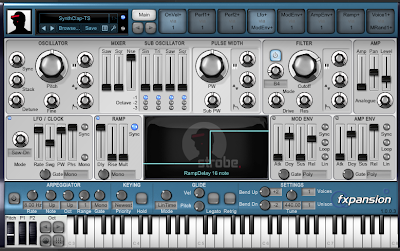
As far as programming drum sounds on a synthesizer goes, hand claps are probably second only to crash cymbals in their difficulty to synthesize convincingly. The truth is, you're not going to get anything akin to an 808 clap sound out of the vast majority of synths. However, with a little work, you can get the sorts of analog clap sounds you might hear on old Human League records. (And if you have never heard their albums "Reproduction
I messed around with a couple of softsynths for this type of sound and found FXpansion's Strobe gave the most satisfactory results to my ears. You should be able to follow along with just about any decent virtual analog, though.
1. Start with an INIT type preset. Strobe defaults to this, so if you're using it, you'll be ready to go. Hand claps, much like snares, are primarily noise based. So the first thing you'll want to do is to head over to the MIXER section and raise the NSE (noise) slider all the way up. We won't need any tone like you do with a snare sound, so we'll turn the SAW and SQR sliders all the way down. Make sure all the Strobe's SUB OSCILLATOR sliders are turned down all the way, too.
2. The first thing we're going to want to do is to program the amplitude envelope which shapes the volume contour of the sound. This is a percussive sound, so head over to the AMP ENV and set the ATK (attack) and SUS(tain) sliders all the way down to 0. Set your DCY (decay) slider to a fairly high value (I set mine to 2.05 seconds), and jack the REL (release) slider all the way up. We want the sound to play all the way through no matter how long we hold down a key.
3. Next, let's set up the filter. Make sure the FILTER is turned on (the little power switch in the upper left hand corner should be lit up). You can experiment with different filter types, but bandpass filters are generally best suited for this kind of sound. So change Strobe's FILTER MODE to B4 for a bandpass filter with a fairly steep cutoff. Speaking of which, set your CUTOFF value to a fairly high value (I chose +57.00). This already sounds better, but to give the sound a bit more of a 'crack', turn up the RES(onance) up a bit to around 39%.
4. You should have something akin to a synthy snare at this point, but it doesn't really sound very "clappy" yet. That's because when you have a group of people clapping their hands, the impact of each person's hands is not occurring at the exact same time. We can emulate this effect by using a downward ramp waveform on the LFO to modulate the sound's amplitude. The 4th modulation slot from the left in Strobe should already be set to LFO+ as a source, so go ahead an select it. Strobe has a cool modulation system that lets you modulate any number of parameters from a single source very easily. Go ahead and turn the AMP level down in the AMP section. You'll notice the slider is split into two parts. Drag the upper part to the top and you should see a yellow line in the slider window. This represents the range of modulation.
5. We're almost done! Head on over to the LFO section and set the MODE to SAW-DN. The SWG, PW, and PHS values can be used to further shape the LFO that is modulating our AMP level. Adjust this to taste. Also, make sure the SYNC button is turned off. Now we have something that sounds a little bit more like a bunch of hands clapping slightly out of time with one another. If your synth allows you to set a fade out value on your LFO, set this to a fairly short length so we're just getting that chaotic bit at the initial impact of the sound.
6. You should have something vaguely resembling a hand clap sound at this point, but to take it to that next level, try adding a little bit of short reverb to flesh things out a bit. If you've done everything correctly, you should have something that sounds vaguely like this:
And here's the patch for Strobe users.
Labels:
Drums,
Roll Your Own Sounds,
Sound Design,
Synth Programming
Subscribe to:
Comments (Atom)

